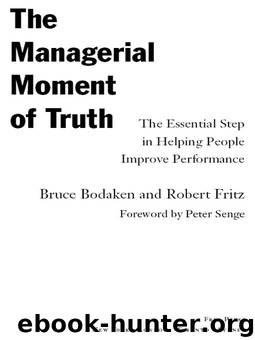The Managerial Moment of Truth by Bruce Bodaken & Robert Fritz

Author:Bruce Bodaken & Robert Fritz
Language: eng
Format: epub
Publisher: Free Press
Published: 2006-07-15T00:00:00+00:00
“This month sales are up by 22 percent above plan.”
“Yeah, I guess we got lucky.”
“We’ve noticed that your team released the product early and under budget.”
“They’re a good group.”
These types of “aw-shucks” responses often are seen as good manners. Many people are taught not to brag about their accomplishments. However, the realm of truth demands that truth be told. Sometimes the truth is that the person did one hell of a job, and the outcome wouldn’t have been as good had he not performed as well as he did.
Step one is about acknowledgment. As in a corrective MMOT, we need to do more than just announce reality. We need to get agreement about the difference between the expected result and the actual outcome. There isn’t any difference in the form of step one, be it corrective or positive, except that the content is much more pleasant. Because of our dedication to creating a platform for truth in the organization, we are using the positive MMOT to deepen our understanding of reality. We are not simply complimenting work that was well done; we are mentoring, exploring the processes that led to the success, and learning what we can use in the future. In step two we will analyze how the person produced such great performance. Step one is simply acknowledgment of the performance.
“This month sales are up by 22 percent above plan.”
“Yeah, I guess we got lucky.”
“We’ll take a look at how Lady Luck came into your life in a moment, but, just to make sure we agree, am I right about sales being up 22 percent above plan?”
“Yes.”
Step Two: Analyze How it Happened
During this step in the positive MMOT, we track just how the person (or team) achieved the result. This is the same process as in the corrective MMOT. It may be useful to track the story by sequence: what happened first, and then what happened.
The sequencing technique is very useful when people have blind spots and can’t see where they typically make their mistakes. Usually a blind spot does not contribute to an outstanding outcome as it does in a corrective MMOT. The person may have made good or well-executed decisions that were creative, flexible, and strategic. Perhaps we need to help the person move from “unconscious competence” to “conscious competence.” There may be useful lessons that will be replicable.
One of the most common ways to address step two is to “cut to the chase”—in other words, ask the person how we can account for the performance.
Download
This site does not store any files on its server. We only index and link to content provided by other sites. Please contact the content providers to delete copyright contents if any and email us, we'll remove relevant links or contents immediately.
Bullshit Jobs by David Graeber(3830)
Radical Candor by Kim Scott(2579)
I Am Right, You Are Wrong by Edward De Bono(2339)
23:27 by H. L. Roberts(2140)
Nomadland by Jessica Bruder(1955)
Average Is Over by Tyler Cowen(1758)
The Conflict Resolution Phrase Book by Barbara Mitchell & Cornelia Gamlem(1646)
Out of Our Minds: Learning to Be Creative by Ken Robinson(1628)
High-Impact Interview Questions by Victoria A. Hoevemeyer(1611)
The Ideal Team Player by Patrick M. Lencioni(1562)
An Everyone Culture: Becoming a Deliberately Developmental Organization by Robert Kegan & Lisa Laskow Lahey(1527)
The Asshole Survival Guide by Robert I. Sutton(1504)
Automatic Society by Bernard Stiegler(1462)
Who by Street Randy & Smart Geoff(1421)
Unleashed by Anne Morriss & Frances Frei(1421)
Who Moved My Cheese?: An Amazing Way to Deal With Change in Your Work and in Your Life by Johnson Spencer(1417)
42 Rules of Employee Engagement by Susan Stamm(1396)
96 Great Interview Questions to Ask Before You Hire by Paul Falcone(1354)
The Power of Disability by Al Etmanski(1286)
